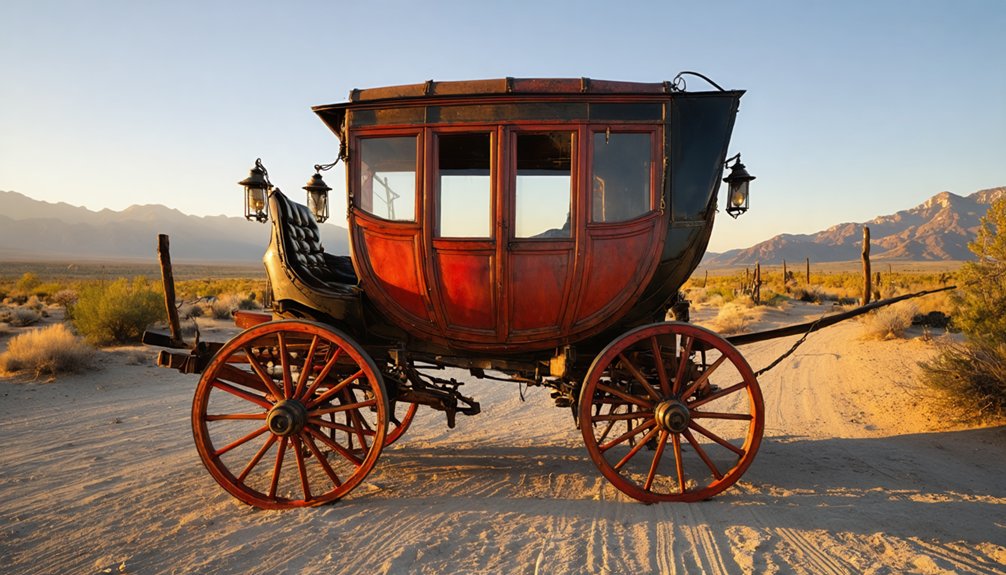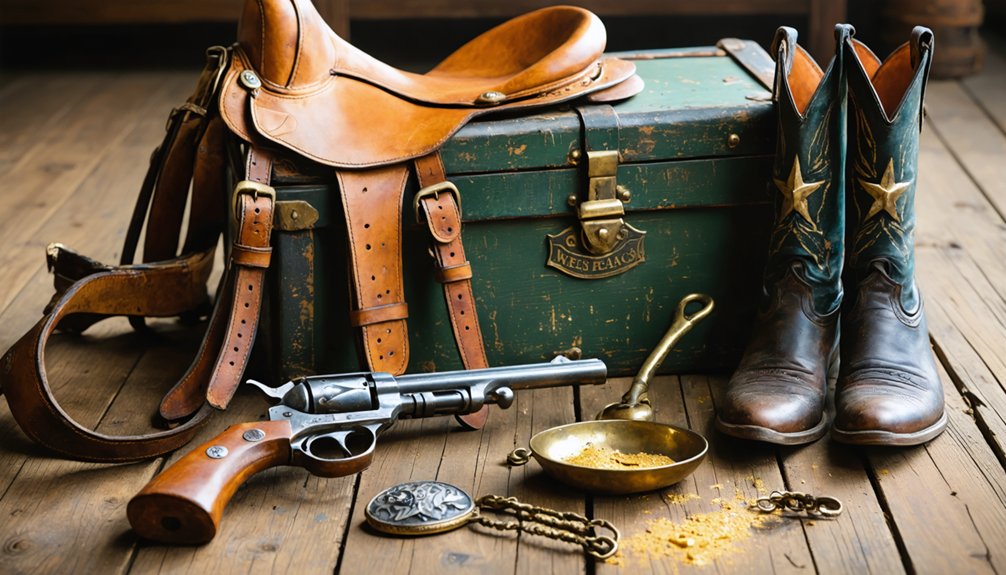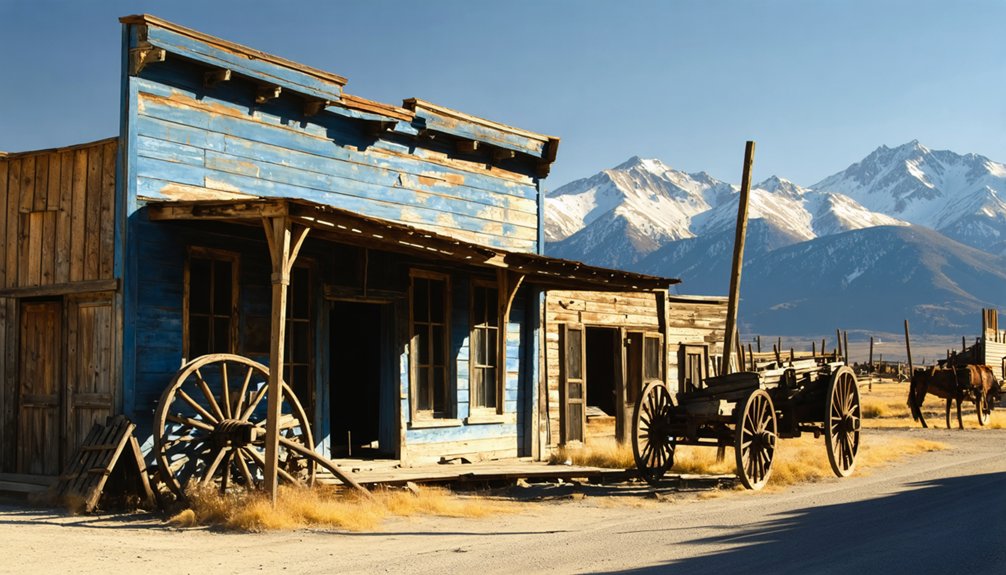The American West’s best-preserved relics include Old Trail Town‘s 1879-1901 authentic buildings, Tombstone’s 1882 Victorian courthouse, Old Sacramento’s Gold Rush architecture, South Park City’s 60,000 mining artifacts, Kerrville’s 150 Western sculptures, the Western Spirit miniature collection, and original frontier tools like Wells Fargo strongboxes. You’ll find wooden sidewalks, cobblestone streets, and Native American beadwork that transport you directly to the rugged reality of 19th-century frontier life. These seven sites offer unparalleled windows into America’s untamed past.
Key Takeaways
- Old Trail Town in Cody, Wyoming preserves 26-28 authentic Wild West buildings dating from 1879-1901 relocated from across Wyoming and Montana.
- The Gold Rush-era buildings in Old Sacramento represent America’s largest concentration of commercial structures from this pivotal historical period.
- Tombstone’s Historic Courthouse, built in 1882 for $50,000, showcases Wild West justice with original furniture, weapons, and historical photographs.
- South Park City Museum houses over 60,000 frontier artifacts illustrating mining techniques and daily life from 1860-1900.
- The Museum of Western Art in Kerrville features approximately 150 sculptures and 250 paintings depicting authentic Western frontier life.
Old Trail Town: Buffalo Bill’s Living Western Museum
Standing as a tribute to the American frontier, Old Trail Town was established in 1967 by Bob Edgar, a dedicated archaeologist and historian committed to preserving the heritage of the Wild West.
Old Trail Town stands as a living monument to America’s rugged frontier spirit, preserved for future generations.
Located on the original townsite of “Cody City,” laid out by Buffalo Bill Cody himself in 1895, this outdoor museum sits just east of Yellowstone National Park.
You’ll discover 26-28 authentic buildings dating from 1879-1901, carefully relocated from throughout Wyoming and Montana. After recognizing the rapid disappearance of buildings from the historic landscape, Edgar began collecting and preserving these structures.
From Butch Cassidy’s cabin to a functioning blacksmith shop, each structure offers glimpses into genuine frontier life. Buffalo Bill’s Wild West Show once presented military drill performances that reflected the historical narratives of Western expansion.
The museum houses thousands of historical artifacts including an impressive collection of horse-drawn vehicles, Native American beadwork, and tools that pioneers relied upon daily.
The cemetery even features the grave of mountain man John Johnston, immortalized in “Jeremiah Johnson.”
Tombstone’s Historic Courthouse: Justice in the Wild West
Built in 1882 at a cost of $50,000, Tombstone’s Historic Courthouse stands as one of Arizona’s most significant Victorian-era structures and a tribute to frontier justice.
The red brick building’s distinctive Roman cross courtroom architecture housed all county operations until 1929 when the county seat relocated to Bisbee.
You’ll find authentic exhibits showcasing Wild West justice through original furniture, weapons, and thousands of historical photographs. As the oldest courthouse still standing in Arizona, the building offers visitors a unique glimpse into territorial legal proceedings.
The replica gallows in the courtyard commemorates seven men executed during the territorial era—a stark reminder of frontier law enforcement practices.
In 1959, the courthouse became Arizona’s first operational state park following extensive restoration efforts. The transfer to the Parks Board included both the building’s contents and a 99-year lease from the City of Tombstone.
Now listed on the National Register of Historic Places, this perfectly preserved cornerstone of Tombstone continues to tell the story of law and order in the American frontier.
Gold Rush Heritage at Old Sacramento Landmark
Walking along Old Sacramento’s authentic wooden sidewalks, you’ll encounter one of America’s most significant Gold Rush commercial hubs, recognized as a National Historic Landmark in 1965.
The district’s preserved 1850s architecture, including the 1849 Eagle Theater and 1855 Big Four Building, showcases the rapid development triggered by California’s gold boom.
This riverfront trade center, which served as the western terminus for the Pony Express, transcontinental railroad, and telegraph systems, remains a living museum with cobblestone streets and Victorian-era structures that attract five million visitors annually. The area regularly hosts festivals throughout the year that celebrate its rich historical significance while engaging both tourists and local community members. The California State Railroad Museum within the district offers extensive exhibits that highlight transportation’s crucial role in supporting miners during the Gold Rush era.
Riverfront Trade Hub
The confluence of the American and Sacramento Rivers birthed what would become one of America’s most significant Gold Rush commercial centers. When gold was discovered in 1848, merchants like Sam Brannan quickly established businesses along Sacramento’s waterfront, creating a bustling hub of river commerce.
You’ll find the remnants of a critical outfitting point where forty-niners purchased supplies before heading to the goldfields. This waterfront district thrived despite devastating floods and fires, with the city ultimately raising its street level—preserving original infrastructure now visible underground. What began as Sutter’s Embarcadero transformed into the commercial heart of early California.
The district’s trade expansion was fueled by riverboats delivering miners and merchandise, making it the West’s premier distribution center.
Today, this 28-acre historic district contains 53 preserved buildings, offering you a rare glimpse into authentic Gold Rush infrastructure—a reflection of American entrepreneurial spirit along the frontier. Similar to the River District’s industrial past, this area once served as a major shipping hub with warehouses and distribution centers supporting California’s growth.
Gold Boom Architecture
Old Sacramento’s architectural treasure trove stands as America’s largest concentration of Gold Rush-era commercial buildings, with 53 historic structures spanning 28 acres.
You’ll notice the Victorian influence throughout, with multi-story structures featuring full-height balcony windows that showcase the waterfront district’s former prosperity.
Wooden sidewalks and cobblestone streets transport you to the mid-19th century, while the blend of mining town aesthetics with West End Spanish colonial elements—arched doorways and wrought iron balconies—reflects the area’s cultural diversity.
The Lady Adams Building, the oldest non-residential structure, survived devastating fires and floods, while the B.F. Hastings Building once housed both the Pony Express terminus and California’s first Supreme Court.
These elevated buildings preserve the original infrastructure underneath, making Old Sacramento one of California’s most historically significant archaeological sites. This preservation occurred when the city foundations were raised to prevent flooding, protecting the original Gold Rush-era structures for future generations to study and appreciate.
The area attracts over 5 million visitors annually who come to experience this living history center comparable to Colonial Williamsburg.
South Park City: Colorado’s Preserved Mining Heritage
Nestled in Fairplay, Colorado, South Park City Museum stands as a remarkable living history tribute to America’s frontier mining era.
You’ll discover 44 authentic buildings, most salvaged from abandoned ghost town preservation sites that once thrived during the 1859 gold rush. Seven structures remain on their original foundations while others were meticulously relocated from vanishing mining camps.
The museum opened in 1959, exactly a century after gold was first discovered in South Park.
A fitting centennial tribute, South Park City Museum brings frontier history alive exactly 100 years after the rush began.
As you explore, you’ll encounter over 60,000 artifacts illustrating mining techniques and daily life between 1860-1900. Each building is authentically furnished, from the stamp mill demonstrating ore processing to household items donated by local families.
This National Register site offers an unfiltered window into boom town economics and frontier spirit that defined the American West.
Western Art Treasures at Kerrville’s Premier Museum

At Kerrville’s Western art museum, you’ll discover approximately 150 sculptures and 250 paintings that authentically capture frontier life through the masterful works of Cowboy Artists of America founders like George Phippen and Joe Beeler.
The museum’s extensive collection features bronze sculptures depicting cowboys in action alongside oil paintings that document Native American cultural traditions with remarkable attention to historical detail.
You can appreciate the artistic legacy of the Old West through rotating exhibitions that showcase both established Western artists and emerging talents who continue to interpret frontier heritage through contemporary perspectives.
Acclaimed Western Masterpieces
The Museum of Western Art in Kerrville stands as a tribute to artistic excellence, having been named the Number One Western Art Museum in the country for 2025 by True West Magazine. This recognition reflects the museum’s outstanding cultural significance in preserving Western heritage through its exceptional collection.
You’ll discover approximately 150 sculptures and 250 paintings showcasing the American West’s spirit. Works by renowned artists including George Phippen, Joe Beeler, and Oreland Joe capture authentic Western experiences across various mediums. The collection spans Western Realism, oils, pastels, watercolors, and bronze sculptures.
The museum’s architectural design by O’Neil Ford complements these treasures with hacienda-style elements—boveda ceilings, mesquite wood floors, and stucco walls—creating an immersive environment where you can experience these acclaimed Western masterpieces in their proper cultural context.
Frontier Life Sculptures
Vivid frontier life sculptures form the cornerstone of the Museum of Western Art‘s collection in Kerrville, bringing the Old West to three-dimensional life through approximately 150 masterfully crafted works.
You’ll find impressive life-sized bronze pieces scattered throughout the museum’s 10-acre grounds, complemented by the hacienda-style architecture designed by O’Neil Ford.
The collection emphasizes authentic frontier life representation through Western Realism, with works from original Cowboy Artists of America members who meticulously captured cowboy culture and heritage.
Master sculptor Oreland Joe’s pieces stand among the most notable in the collection.
The museum’s architectural features—including boveda domes, mesquite wood flooring, and stucco walls—create an intimate atmosphere that enhances your appreciation of these three-dimensional cultural heritage treasures.
Native Cultural Representations
Nestled within Kerrville’s Museum of Western Art, a remarkable collection of Native American cultural representations provides visitors with nuanced artistic perspectives on indigenous life during America’s westward expansion.
You’ll discover these powerful Native American narratives integrated throughout the museum’s exhibitions, often appearing alongside frontier and cowboy themes. The artworks document indigenous experiences through Western artistic traditions, capturing the cultural resilience demonstrated during times of significant change and conflict.
The museum’s research library enhances this cultural documentation with historical materials dating back to the mid-19th century, offering scholars and visitors alike a deeper understanding of Native American heritage.
Through oils, watercolors, and bronze sculptures, these pieces preserve indigenous stories while acknowledging the complex historical relationships between Native peoples and American expansion.
The Spirit of the Old West: Miniature History in California

California’s historical landscape reveals a miniature world of Old West preservation, where five distinctive museums offer visitors immersive glimpses into frontier life.
The Blackhawk Museum‘s Spirit of the Old West exhibition in Danville showcases realistic miniature exhibits of buffalo herds and frontier settlements, chronicling Native American culture alongside settler experiences from the 1700s to early 1900s.
At Fresno Flats Historic Village, you’ll discover historical replicas including authentic pioneer homes and two one-room schoolhouses.
The Autry Museum impresses with its replica Western town, while Gilman Ranch preserves original Victorian structures and Gold Rush artifacts.
Laws Railroad Museum completes this frontier experience with its 1883 depot and reconstructed pioneer town.
Each venue transforms California’s vast history into accessible, detailed microcosms of Western heritage.
Authentic Frontier Artifacts That Shaped the American West
While California’s museums showcase miniature recreations of the Old West, the physical artifacts themselves tell a more tangible story of frontier life.
Beyond dioramas and models, authentic frontier objects reveal the West’s true narrative through their weathered authenticity.
When you examine authentic frontier relics, you’re touching the very tools that built America’s western expansion.
The most significant frontier artifacts include:
- Cowboy gear like E.H. Davison’s boots and chaps, which belonged to Montana’s finest bronc rider, or the intricately crafted Main & Winchester saddles that commanded premium prices over mass-produced alternatives.
- Mining tools from the 1848 Gold Rush used by the 300,000 prospectors who flooded into California by 1850, including gold dust containers and assaying equipment.
- Wells Fargo strongboxes that secured precious metals during transportation, representing the complex security systems protecting frontier wealth.
Frequently Asked Questions
How Accessible Are These Sites for Visitors With Mobility Limitations?
You’ll find robust wheelchair accessibility at these historic sites, with ramps, designated routes, and accessible restrooms. Visitor services include shuttle transportation with wheelchair lifts and rentable mobility equipment for your exploration.
What Preservation Techniques Keep These Artifacts From Deteriorating?
You’ll find strict environmental control, proper handling with gloves, controlled cleaning, stabilization with specialized resins, and detailed documentation are all critical artifact conservation and preservation methods preventing deterioration.
Do Any Sites Offer Hands-On Experiences With Historical Items?
Diving into history hands-first, you’ll find interactive exhibits at Buffalo Bill Center, Autry Museum, and Living History Farms where historical reenactments let you touch authentic Old West artifacts and tools.
Are There Overnight Accommodations That Maintain the Old West Atmosphere?
You’ll find authentic Old West atmosphere in historic inns like Buffalo Bill’s Irma Hotel and cowboy cabins at working dude ranches like Tombstone Monument Ranch, blending period authenticity with modern comfort.
How Accurate Are the Restorations Compared to Historical Documentation?
Most Old West restorations achieve high accuracy when backed by solid historical documentation, though you’ll find varying degrees of authenticity depending on available research and each site’s preservation commitment.
References
- https://www.vacationsmadeeasy.com/TheBLT/20RealOldWildWestAttractionsYouHavetoSeetoBelieve679.html
- https://www.archives.gov/research/american-west
- https://www.museumofwesternart.com
- https://dot.ca.gov/-/media/dot-media/programs/environmental-analysis/documents/ser/townsites-a11y.pdf
- https://www.truewestmagazine.com/article/top-art-museums-of-the-west-2025/
- https://thewarriormuse.blogspot.com/2012/05/my-to-z-expedition-into-wild-west.html
- https://blackhawkmuseum.org/the-spirit-of-the-old-west/
- https://en.wikipedia.org/wiki/Wikipedia:NRHP
- https://www.westernlifetoday.com/must-visit-western-museums/
- https://now.acs.org/About/browse/default.aspx/Real_About_The_Wild_West.pdf



